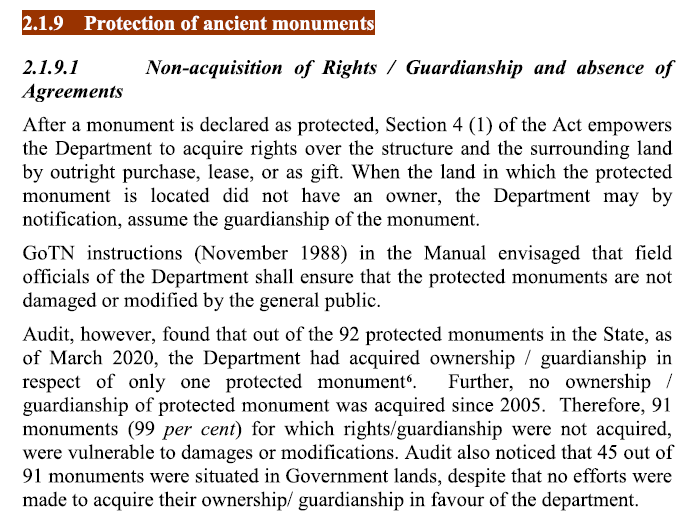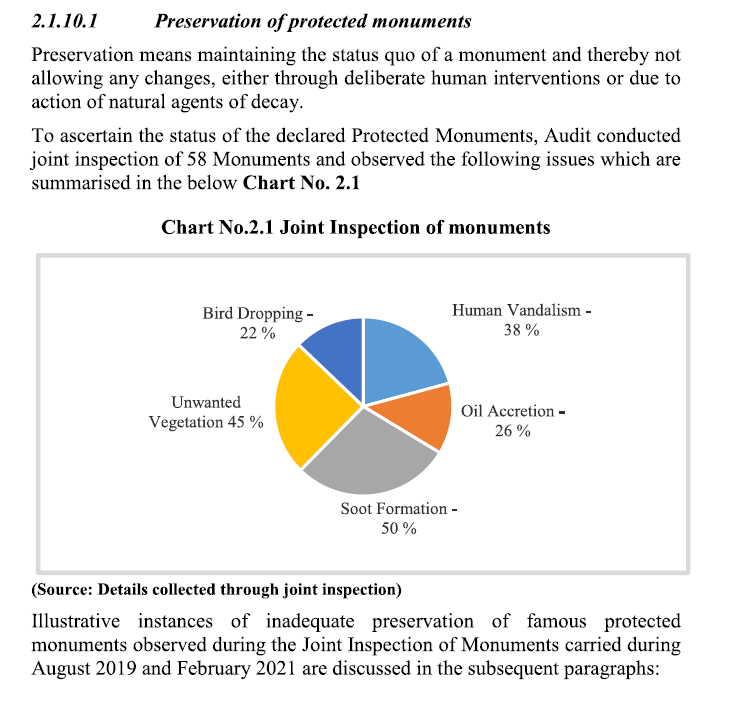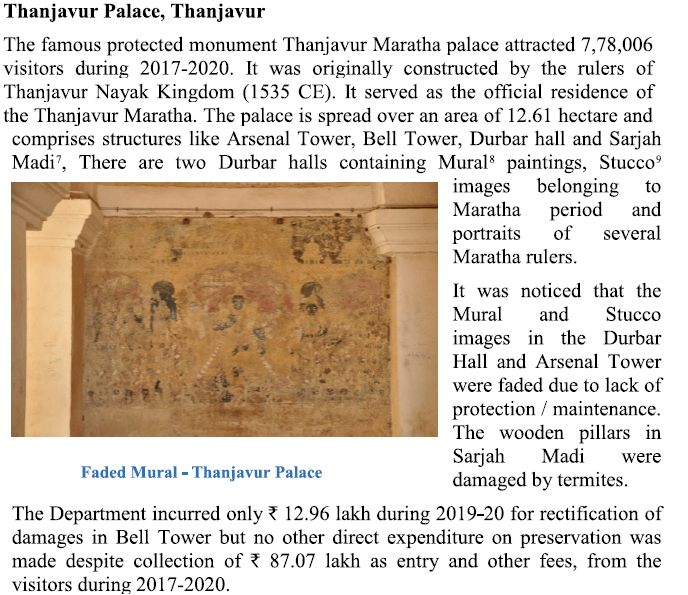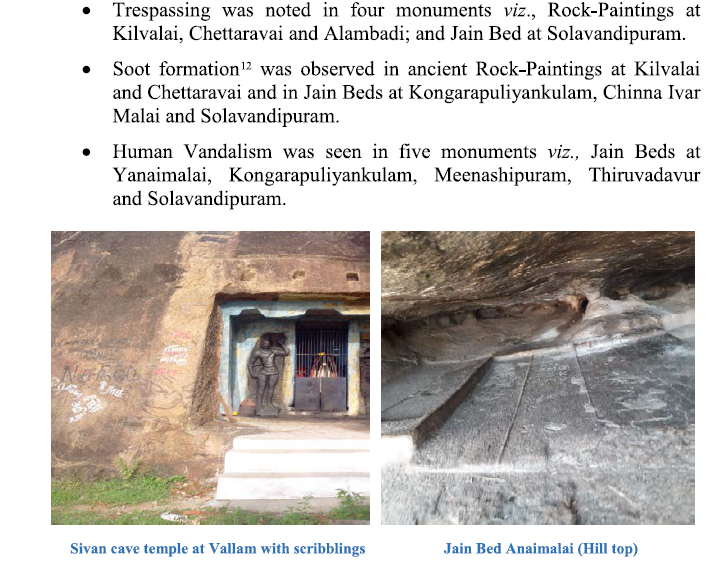TN government has been violating Acts and Rules in the case of protecting Monuments, Temples etc., as pointed out by the CAG in its report March 2022.

Government of Tamilnadu – Report No.6 of 2021 – Complaiance audit Report for the year ended March 2020: Actually, the Audit report of Tourism, culture and Religious Endowment Depatment runs into many pages with facts and figures, photos, lists of monuments etc[1]. The present government might dodge and escape blaming the previous government, but, the people of Tamilnadu know very well that the present Dravidian stock and Dravidian model, periyarist, atheist, anti-Hindu government has bee the worst as could be noted from its past record from 1960s. Their leaders have been well-known for breaking idols, beating Hindus God pictures with chappals, misappropriating temple funds and looting the temple properties. The Supreme and High Court cases, judgments and reports vouchsafe these details. The Hindu Business Line just published one[2]. Out of the 91 protected monuments in Tamil Nadu, the State’s archaeology department has taken guardianship of just one in Maligaimedu, Ulkota Village of Ariyalur district in 2004. Further, 45 out of the 91 monuments were in government lands and no efforts were made to acquire their ownership, it said[3]. Monuments for which rights/guardianships were not acquired, were vulnerable to damages or modifications, observed the Compliance Audit Report of the Comptroller and Auditor General of India (CAG) for the year ended March 31, 2020[4].

Modification done: The Tamil Nadu’s Department of Archaeology, which identifies, conserves and preserves ancient monuments, has failed to acquire ownership of 99 per cent of the declared protected monuments.
- A notified protected monument at Vishnu Koil, Ulagapuram, a stone temple with a unique style and inscriptions of Rajendra Chola I era (1012-044 CE), the villagers, had constructed an additional superstructure. . The officials identified it in September 2016 after the completion of 15 ft of additional structure. They stopped the unauthorised construction in November 2017.
- Within the protected area of Karunguzhi Fort built by the Mohammeddans in 17th Century CE, a sewage treatment plant (STP) was constructed by the Karunguzhi Town Panchayat, damaging the monument. The construction activities could not be stopped since the department did not have any right over the property as per the revenue records. The State government in July 2021 responded by stating that the appropriate steps are being taken, the report said.
After a monument is declared protected, Section 4 (1) of the Tamil Nadu Ancient and Historical Monuments and Archaeological sites and Remains Act, 1966 (Act) empowers the department to acquire right over the structure and the surrounding land by outright purchase, lease or as a gift. When the land in which the protected monument is located does not have an owner, the department may, by notification, assume the guardianship of the monument.

Human vandalism: There was human vandalism; oil accretion; sport formation; vegetative growth and lack of physical protection in monuments.
![*]() At the famous Thanjavur Palace constructed by the rulers of Thanjavur Nayak Kingdom (1535 CE) in 12.61 hectare and served as the official residence of the Thanjavur Maratha, the Mural and Stucco images in the Darbar Hall and Arsenal Tower were faded due to lack of maintenance.
At the famous Thanjavur Palace constructed by the rulers of Thanjavur Nayak Kingdom (1535 CE) in 12.61 hectare and served as the official residence of the Thanjavur Maratha, the Mural and Stucco images in the Darbar Hall and Arsenal Tower were faded due to lack of maintenance.
![*]() Human vandalism was seen in five monuments – Jain Beds at Yanaimalai; Kongarapuliyankulam; Meenakshipuram; Thiruvadrur and Solavandipuram.
Human vandalism was seen in five monuments – Jain Beds at Yanaimalai; Kongarapuliyankulam; Meenakshipuram; Thiruvadrur and Solavandipuram.
![*]() A stone crushing mill was functioning within the protected areas of the Forty-Four British Soldiers Tomb in Thoothukudi district.
A stone crushing mill was functioning within the protected areas of the Forty-Four British Soldiers Tomb in Thoothukudi district.
The State government may declare that the identified ancient monuments should be completed on a priority to enable their maintenance and preservation effectively. The government should ensure adequate steps are taken to maintain the protected monuments and fill up vacant technical posts, the Audit suggested.

November 2021- HC orders Audit report of Temples should be submitted within two weeks: The 36,000 temples, thousands of Mutts and crores of the worth of properties have been regularly embroiled by the vested parties and the violations going to courts. But, most of the cases have been purposely kept pending in the courts, so that the lessees, encroachers and illegally sold and bought persons cool of and enjoy the temple properties. Only a few cases come to courts and get reported in newspapers. R Shanmugasundaram, Advocate General, made the submission before the division bench comprising acting judges, Justice R Mahadevan and Justice PD Audikesavalu[5]. The judges were hearing a petition by Rangarajan Narasimhan, who prayed for a direction to the HR&CE to audit all the temples in the state. On recording the submissions made by the AG, the bench adjourned the matter for two weeks. Also, in another case, Rangarajan Narasimhan wanted the court to direct the government for the appointment of trustees to the HR&CE temples[6]. Responding to this, the AG contended that applications were invited for the post of trustees. But after that, nothing would be reported in the media and the readers and public slowly forget the issue also.

Temple properties sold illegally: The Madras High Court ordered a roving inquiry into a case related to the alleged illegal sale of the properties of a temple in Krishnagiri. Justice R Suresh Kumar, issuing the orders, expressed his shock over the inaction of the Hindu Religious and Charitable Endowments (HR&CE) department, and temple trustees, in retrieving properties illegally sold by third parties[7]. The judge noted that neither the department nor trustees took steps to retrieve two properties, illegally sold by third parties in 2001 and 2007, until a petition was filed by A Radhakrishnan, president of Thiruthondargal Sabai. He had alleged that the properties of the Mariamman temple in Avathanapatti were sold illegally[8]. The judge ordered an inquiry and an audit of accounts. Directing the HR&CE to appoint an officer for the probe, he ordered a report to be filed within six weeks. Again, after six weeks or one and half months what happened is not known[9]. The cases are regularly filed, the issues get exposed but the TN government is unmoved[10]. It is the specific case of the petitioner that the respondents have been violating, destroying and altering the heritage structures, icons, inscriptions, murals and paintings of the temples by claiming to act as per the MPPRI Rules framed under the HR&CE Act. They have not obtained the necessary approval from the Government for carrying out the civil works including construction, renovation, restoration, conservation, repairs etc., inside and adjacent to the temple premises and its properties. Hence, the MPPRI Rules may be declared as ultra vires the clauses (xvii) and (xix) of subsection (2) to Section 116 of the HR&CE Act. The Hindutva groups that contain Central Govt nominated advocates do not work in unison and cooperation like their opponents. In fact, propaganda has been going on among the so-called “Hindutwa” groups, that is exhibited openly in the social media. With the political ambitions, perhaps, they have been colluding with the corrupt.
© Vedaprakash
26-03-2022

[1] Government of Tamilnadu – Report No.6 of 2021 – Complaiance audit Report for the year ended March 2020. Tourism, culture and Religious Endowment Depatment, Chapter-II, Paras. 2.1.9.1 to 2.1.16, pp.11-25.
[2] The Report can be downloaded from here:
[3] The Hindu Business Line, CAG indicts Tamil Nadu for failing to own most of the protected monuments, T.E. Raja Simhan |Updated On: Mar 25, 2022.
[4] https://www.thehindubusinessline.com/news/national/cag-indicts-tamil-nadu-for-failing-to-own-most-of-the-protected-monuments/article65258295.ece
[5] DtNext, Tamil Nadu temples audit reports in 2 weeks, Published: Nov 19, 2021 02:33 AM;
Updated: Nov 19, 2021 02:34 AM
[6] https://www.dtnext.in/News/TamilNadu/2021/11/19023338/1329558/Temples-audit-reports-in-2-weeks.vpf
[7] New Indian Express, Madras High Court orders roving inquiry into sale of temple assets, Published: 19th December 2021 04:02 AM | Last Updated: 19th December 2021 04:02 AM.
[8] https://www.newindianexpress.com/states/tamil-nadu/2021/dec/19/madras-high-court-orders-roving-inquiry-into-sale-of-temple-assets-2397232.html
[9] Madras High Court – T.R.Ramesh vs The State Of Tamil Nadu on 24 August, 2021 – W.P.No.17468 of 2016; IN THE HIGH COURT OF JUDICATURE AT MADRAS; DATED : 24.08.2021
CORAM
THE HONOURABLE MR.JUSTICE R.MAHADEVAN
AND
THE HONOURABLE MR.JUSTICE P.D.AUDIKESAVALU
W.P.No.17468 of 2016
T.R.Ramesh … Petitioner
v.
1. The State of Tamil Nadu, rep.by its Secretary, Department of Tourism, Culture and Religious Endowments, Secretariat, Chennai – 600 009.
2. The Commissioner, Hindu Religious & Charitable Endowments, 119, Mahatma Gandhi Road, Nungambakkam, Chennai-600 034. … Respondents.
[10]https://indiankanoon.org/doc/15186241/
